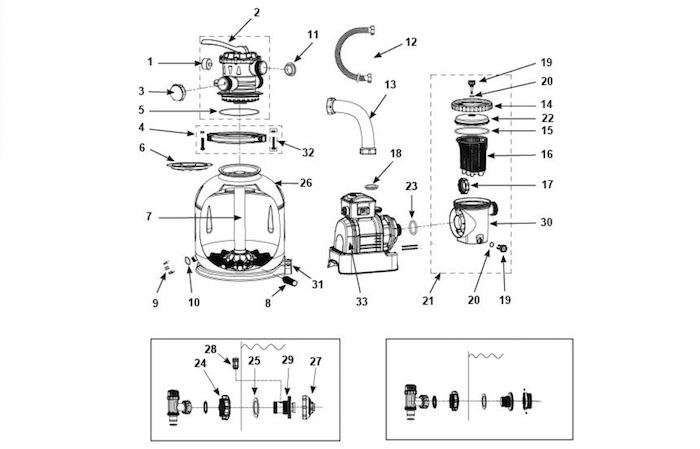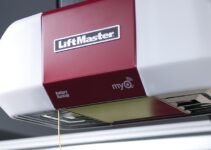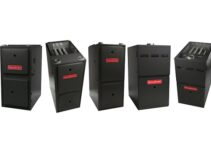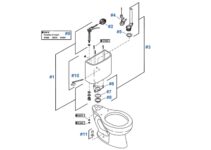The pool pump is the heart of the pool circulation system. Its function is to provide the water flow that appropriately distributes chemicals throughout the pool, enabling it to disinfect the water properly.
Using a skimmer and main drain, It also draws the water from the pool, filters it, and sends it to the pool through the main returns. The Intex pool pump is one of the best to buy in the market.
To help you understand the critical information about the Intex pool pump, we’ll provide a diagram showing the different components in the Intex Pool pump and demystify them.
Intex Pool Pump Parts Diagram
Ensuring the pool pump works efficiently is the most crucial part of pool maintenance. Once the pool pump develops faults, nothing else will work.
Understanding the pool pump’s different components will assist you in quickly diagnosing the problem and repairing the part immediately.
Below is the diagram of the Intex pool pump showing the different components:

The diagram shows the components of all Intex pool pump machines, including the sand filter pump, cartridge pump, salt water system, and combination system.
- Pressure gauge
- 6-way valve
- Electrolytic cell cover
- Clamp
- Tank O-Ring
- Sand Shield
- Center Pipe Hub
- Lateral
- Drain Valve Cap
- Drain Valve O-Ring
- L-shape O-Ring
- Dia Pump Hose
- Interconnecting Hose
- Leaf Trap Nut
- Leaf Trap O-Ring
- Basket
- Filter Housing Nut
- L-Shape O-Ring
- Air Release Valve
- Air Release Valve O-Ring
- Pre-Filter Assembly
- Leaf Trap Cover
- O-Ring
- Strainer Nut
- Flat Strainer Rubber Washer
- Tank
- Adjustable Pool Inlet Jet Nozzle
- Inlet Threaded Air Connector
- Pre-Filter Container
- Sand Filter Pump Tank Base
- Air Jet Valve
- Screw
- Pump Motor and Control
- Air Jet Valve Cap
Intex Pool Pump Parts Explained
The pool pump is a crucial part of the pool’s circulation system, which runs actively every day of the pool period. Thanks to its components, it provides adequate water flow that distributes chemicals throughout the pool and allows water disinfection.
The pool pump contains different categories of components, each with its unique function. Let’s discuss the various functions of the parts.
Shaft Seal
The shaft seal is a crucial component located behind the pump impeller. It’s an ingenious two-piece part that enables the motor shaft to run along the seal plate. It revolves at about 3500 RPM without leaking water along the shaft. As such, it protects the motor and helps avoid leaks.
Seal Plate
The Seal Plate and the Bracket are mounted to the motor just behind the impeller. The name comes around because this component seals up the pump volume and offers a region to install the other backhand of the shaft seal. The shaft deal is a ceramic ring attached to the center of the seal plate.
Strainer Lid
The strainer lid is the pump’s main point of inspection, from which a technician or owner can assess the system’s functionality. The lid’s utility as an inspection point led to its constituents being made of transparent or colored Lexan glass.
This component is most likely faulty when there are many air bubbles or little to no water in it when the pump is working. It could be that there’s an air leak on the suction side.
Motor
Your pool pump’s engine is called the pool pump motor. When water is fed into the impeller through an airtight supply, the motor, which is connected to it, produces pressure and water flow.
The electromagnetic poles attract and repel one another as the motor is electrically powered, spinning the rotor. It creates the force required for the impellers to rotate and move the water.
Modern ECO motors have several settings that enable them to run at slow speeds and save power, unlike older motors that only feature one on/off option.
Impeller
The impeller in your pool pump generates the suction and pumping motion. An impeller uses power to create water flow instead of a turbine, which uses water flow to produce energy.
Water from the pool is drawn toward the suction pipe by the impeller, which transforms the pump’s rotating action into a vortex. Afterward, the vortex is ejected through the filter and back into the pool.
Basket
The Basket is placed directly below the strainer lid. The primary function of the strainer basket is to extract more significant debris before it gets to the more delicate parts of the drivetrain. It helps sieve and trap particles such as leaves, debris, and small stones before they clog the drivetrain or sometimes chip the impeller.
Gaskets and Seals
Gaskets and Seals include help keep air out where it shouldn’t be and put water in its rightful place. When the seal becomes defective, it can result in floods or, worse yet, damage the pump. If you notice bubbling within apertures and seams in your pump, it could indicate that the gaskets and seals are damaged.

![Genie Garage Door Opener Status Light Blinking [FIXED] Genie Garage Door Opener Status Light Blinking [FIXED]](https://techevery.net/wp-content/uploads/2023/01/genie-garage-door-opener-status-light-blinking-211x150.jpg)

